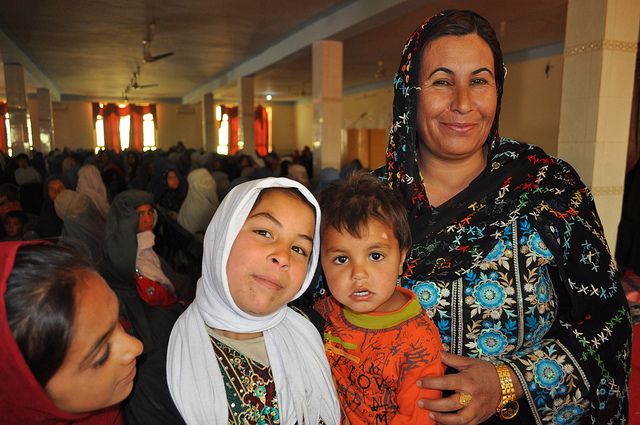[dt_button link=”http://d165vjqq8ey7jy.cloudfront.net/mp3/26363/se-8134s.mp3″ target_blank=”true” button_alignment=”default” animation=”fadeIn” size=”small” style=”default” bg_color_style=”custom” bg_color=”#333333″ bg_hover_color_style=”custom” bg_hover_color=”#444444″ text_color_style=”custom” text_color=”#ffffff” text_hover_color_style=”custom” text_hover_color=”#dddddd” icon=”fa fa-cloud-download” icon_align=”left”]Yuklash[/dt_button]
[dt_divider style=”thin” /]
Transcript:
Voice 1
Welcome to Spotlight. I’m Colin Lowther.
Voice 2
And I’m Liz Waid. Spotlight uses a special English method of broadcasting. It is easier for people to understand – no matter where in the world they live.
Voice 1
It is 1912, in the United States. Women stand in a large group. They are outside a large, dirty factory building. They are protesting the conditions in the factory. Some of the women are holding signs. One of the signs says:
Voice 3
We want bread, but we want roses too.
Voice 2
These women were factory workers. Their work conditions were bad, and they did not earn enough money. Their signs asked for bread – they wanted enough money to feed themselves and their families. But they also demanded roses – beautiful flowers! These flowers were a symbol for a good life – beauty, comfort, and good conditions.
Voice 1
Women are still working for these things. March the 8th is International Women’s Day. On this day, women around the world work for better conditions at work and at home. They work for more leadership positions – in their own communities, in their countries, and the world. Today’s Spotlight is on the history of this important day. We also look at the way women are working for better conditions around the world.
Voice 2
Women’s Day began in the early 1900s. It was a time of great social crisis in Europe and the United States. Before that time, women had mainly worked at home. They cared for their families. Or they helped on family farms. But in the 1900s, women in these countries were starting to enter paid work. They worked mostly in cloth factories.
Voice 1
The workers in these factories worked for low pay. And the working conditions were very poor. These factories were not very safe. The air and light were bad. And workers had to work very long hours. At this time trade unions were developing. These groups worked to protect the rights of all workers. They organized mass strikes – the workers stopped working for some time. There was often conflict between the unions and the owners of factories.
Voice 2
Like the women from the beginning of this program, women also joined these protests. They protested the poor treatment of women factory workers. They hoped to force factory owners to hear their demands.
Voice 1
At the same time, women in the United States were also claiming the right to vote. The Socialist Political Party formed a women’s national committee. This group called for the party to give one day each year to women. On this day, women would work to improve the conditions for other women. National Woman’s Day began the following year, in 1909.
Voice 2
In the year 1910, Women’s Day celebrations became more popular. Many women joined the protests in the United States. Later that year, some of these women went to the International Conference of Socialist Women in Copenhagen in Denmark. They planned to suggest that Women’s Day become an international event.
Voice 1
Other women also played an important part in the history of International Women’s Day. These women pushed against political restrictions in their own countries. They fought for a right to vote. One of these activists was Clara Zetkin. Clara Zetkin was a German socialist leader. She already had a proposal to bring to the Conference of Socialist Women. She proposed that women throughout the world should unite in the struggle for their rights. They should do this on a particular day each year.
Voice 2
Over 100 women from 17 countries attended the conference. They approved Zetkin’s idea. The result was International Women’s Day. Many countries celebrated the first International Women’s Day on March the 8th, 1911. Women in many countries used the day to demand the right for women to vote.
Voice 1
These protests worked! Over time, women have gained many rights. They gained the right to vote. And they gained many other rights too. The celebrations for International Women’s Day expanded too. In 1977, the United Nations encouraged all countries to recognize the day. Each year, the UN holds a conference to encourage women’s rights, and women’s leadership in the world. And today, many countries do celebrate the day. Communities, governments and organizations hold different events. Here are just some of the ways that people celebrate Women’s Day.
Voice 2
Women’s Day is an official holiday in many countries. In some places, like Russia, no one has to work. In other places, like China, only women get a day off!
Voice 1
Even in places where Women’s Day is not a holiday, people still celebrate. In Chile and Albania, men may give women small presents, like flowers or chocolate.
Voice 2
In Mali, women have the day off work. Women’s groups organise debates on women’s issues. These include women’s rights, conflicts and education. Throughout the day, television shows talk about women’s issues. At night, people celebrate with parties.
Voice 1
In Kenya, all through the day, women attend different conferences. Women’s groups aim to give more economic power to women. Women already successfully manage projects. These include water projects, farming and small businesses. The newspapers report stories of these successful women. These women are people who have made a difference in the country in some way. They may have influenced the country’s politics or economy. Or they may have had a good effect on people through their jobs.
Voice 2
No matter how a country celebrates the day, it is important to do something. How will you celebrate International Women’s Day? Write and tell us on our website, www.radioenglish.net.
Voice 1
The writer of this program was Marina Santee. The producer was Michio Ozaki. The voices you heard were from the United States and the United Kingdom. All quotes were adapted for this program and voiced by Spotlight.
Voice 2
You can visit Spotlight on the Internet. Our address is www.radioenglish.net. There, you can listen to this program again, and read it at the same time. This program is called, ‘International Women’s Day’. The website also has many other Spotlight programs, our word list, more information, and comments from other listeners.
Voice 1
You can also receive Spotlight programs every week, directly to your computer, with the Spotlight podcast. Just follow the podcast link on the Spotlight website: radioenglish.net.
Voice 2
If you have a comment or question about any Spotlight program you can email us at radio@radioenglish.net. Or you can leave a comment on the script page of the program on our website, radioenglish.net. We hope you can join us again for the next Spotlight program. Goodbye!




